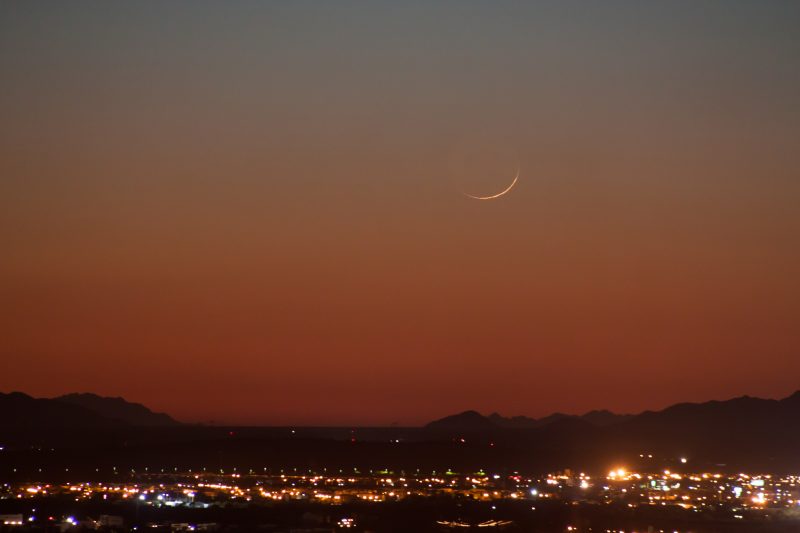On the evenings of January 7 to 9, 2019 – given clear skies – many of us around the world will spot the slender young moon in the west at evening twilight. But don’t delay – especially on the evening of January 7 – when the moon will set before nightfall. On that night, an unobstructed horizon in the direction of sunset and a pair of binoculars will assist you on your young moon quest. If you miss the moon at dusk on January 7, try again on January 8 or 9, when the moon will be easier to spot.
Best New Year’s gift ever! EarthSky moon calendar for 2019
The moon moves eastward in its orbit around Earth. So, day by day, the moon will move farther east of the setting sun, to appear as a wider crescent higher up after the sun goes down. The moon will also stay out longer after dark on January 8 and 9 than it will on January 7. Click here to find out the setting times for the moon and sun in your sky, remembering to check the moonrise and moonset box.
Read more: 4 keys to understanding moon phases
If you do see the moon on these early January 2019 evenings, look for earthshine on the darkened portion of the moon. A moon with earthshine is not a moon in eclipse; no shadow or world in space is obscuring any other. Instead, you’re simply seeing the nighttime side of the moon, and, as it happens, the lunar night is flooded with earthshine – sunlight reflected from Earth to the moon.
Why? Consider that when the moon appears as a slender crescent in Earth’s sky, the Earth appears as an almost-full waning gibbous Earth in the moon’s sky.
Earthshine is twice-reflected sunlight – sunlight reflected from the Earth to the moon, and then from the moon back to Earth.

On the average, the moon moves some 13 degrees eastward per day in front of the backdrop stars of the zodiac. Meanwhile, as seen from Earth, the sun appears to move one degree eastward per day along the ecliptic. In other words, the moon moves an average of 12 degrees east of the sun daily. For reference, the angular diameter of the sun and moon span about one-half degree of sky. This movement of the moon on our sky’s dome is, of course, due to the moon’s motion in orbit around Earth.
The January new moon happened on January 6 at 01:28 Universal Time. For us in the United States, that translated to January 5 at 8:28 p.m. EST, 7:28 p.m. CST, 6:28 p.m. MST, 5:28 p.m. PST and 4:28 p.m. Alaskan Time.
So, after sunset on January 7, the moon will be about two days old for the Pacific Coast of North America. For the Atlantic Coast, after sunset January 7, the moon will be a few to several hours younger than two days old.
At comparable latitudes in the world’s Eastern Hemisphere – Europe, Africa and Asia – the January 7 young moon will exhibit a thinner crescent hovering closer to the horizon. Click here for the time of moonset in your sky, remembering to check the moonrise and moonset box..

Bottom line: Given an unobstructed horizon in the direction of sunset, and a clear sky, look for the thin waxing crescent moon to appear low in the sky and close to the horizon around one hour after sunset on January 7, 2019.
EarthSky astronomy kits are perfect for beginners. Order today from the EarthSky store











